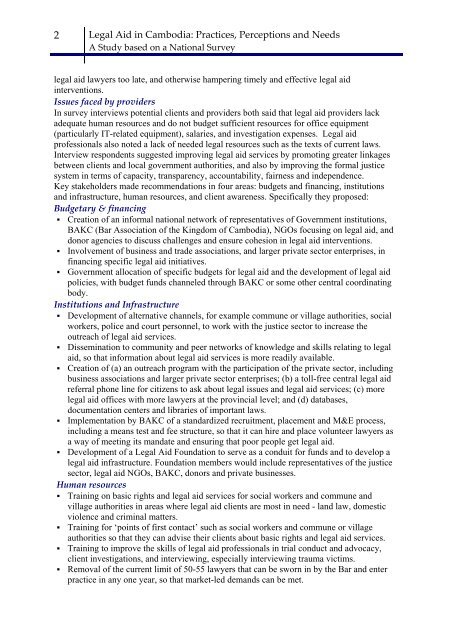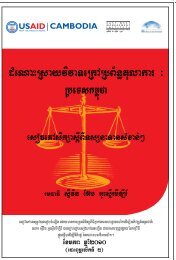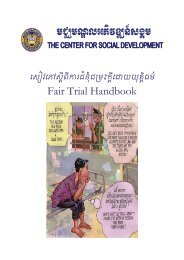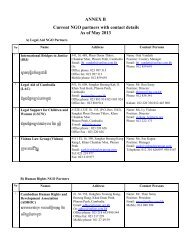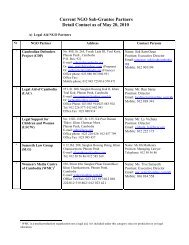Legal Aid in Cambodia: Practices, Perceptions and Needs - PRAJ
Legal Aid in Cambodia: Practices, Perceptions and Needs - PRAJ
Legal Aid in Cambodia: Practices, Perceptions and Needs - PRAJ
Create successful ePaper yourself
Turn your PDF publications into a flip-book with our unique Google optimized e-Paper software.
2<strong>Legal</strong> <strong>Aid</strong> <strong>in</strong> <strong>Cambodia</strong>: <strong>Practices</strong>, <strong>Perceptions</strong> <strong>and</strong> <strong>Needs</strong>A Study based on a National Surveylegal aid lawyers too late, <strong>and</strong> otherwise hamper<strong>in</strong>g timely <strong>and</strong> effective legal aid<strong>in</strong>terventions.Issues faced by providersIn survey <strong>in</strong>terviews potential clients <strong>and</strong> providers both said that legal aid providers lackadequate human resources <strong>and</strong> do not budget sufficient resources for office equipment(particularly IT-related equipment), salaries, <strong>and</strong> <strong>in</strong>vestigation expenses. <strong>Legal</strong> aidprofessionals also noted a lack of needed legal resources such as the texts of current laws.Interview respondents suggested improv<strong>in</strong>g legal aid services by promot<strong>in</strong>g greater l<strong>in</strong>kagesbetween clients <strong>and</strong> local government authorities, <strong>and</strong> also by improv<strong>in</strong>g the formal justicesystem <strong>in</strong> terms of capacity, transparency, accountability, fairness <strong>and</strong> <strong>in</strong>dependence.Key stakeholders made recommendations <strong>in</strong> four areas: budgets <strong>and</strong> f<strong>in</strong>anc<strong>in</strong>g, <strong>in</strong>stitutions<strong>and</strong> <strong>in</strong>frastructure, human resources, <strong>and</strong> client awareness. Specifically they proposed:Budgetary & f<strong>in</strong>anc<strong>in</strong>g• Creation of an <strong>in</strong>formal national network of representatives of Government <strong>in</strong>stitutions,BAKC (Bar Association of the K<strong>in</strong>gdom of <strong>Cambodia</strong>), NGOs focus<strong>in</strong>g on legal aid, <strong>and</strong>donor agencies to discuss challenges <strong>and</strong> ensure cohesion <strong>in</strong> legal aid <strong>in</strong>terventions.• Involvement of bus<strong>in</strong>ess <strong>and</strong> trade associations, <strong>and</strong> larger private sector enterprises, <strong>in</strong>f<strong>in</strong>anc<strong>in</strong>g specific legal aid <strong>in</strong>itiatives.• Government allocation of specific budgets for legal aid <strong>and</strong> the development of legal aidpolicies, with budget funds channeled through BAKC or some other central coord<strong>in</strong>at<strong>in</strong>gbody.Institutions <strong>and</strong> Infrastructure• Development of alternative channels, for example commune or village authorities, socialworkers, police <strong>and</strong> court personnel, to work with the justice sector to <strong>in</strong>crease theoutreach of legal aid services.• Dissem<strong>in</strong>ation to community <strong>and</strong> peer networks of knowledge <strong>and</strong> skills relat<strong>in</strong>g to legalaid, so that <strong>in</strong>formation about legal aid services is more readily available.• Creation of (a) an outreach program with the participation of the private sector, <strong>in</strong>clud<strong>in</strong>gbus<strong>in</strong>ess associations <strong>and</strong> larger private sector enterprises; (b) a toll-free central legal aidreferral phone l<strong>in</strong>e for citizens to ask about legal issues <strong>and</strong> legal aid services; (c) morelegal aid offices with more lawyers at the prov<strong>in</strong>cial level; <strong>and</strong> (d) databases,documentation centers <strong>and</strong> libraries of important laws.• Implementation by BAKC of a st<strong>and</strong>ardized recruitment, placement <strong>and</strong> M&E process,<strong>in</strong>clud<strong>in</strong>g a means test <strong>and</strong> fee structure, so that it can hire <strong>and</strong> place volunteer lawyers asa way of meet<strong>in</strong>g its m<strong>and</strong>ate <strong>and</strong> ensur<strong>in</strong>g that poor people get legal aid.• Development of a <strong>Legal</strong> <strong>Aid</strong> Foundation to serve as a conduit for funds <strong>and</strong> to develop alegal aid <strong>in</strong>frastructure. Foundation members would <strong>in</strong>clude representatives of the justicesector, legal aid NGOs, BAKC, donors <strong>and</strong> private bus<strong>in</strong>esses.Human resources• Tra<strong>in</strong><strong>in</strong>g on basic rights <strong>and</strong> legal aid services for social workers <strong>and</strong> commune <strong>and</strong>village authorities <strong>in</strong> areas where legal aid clients are most <strong>in</strong> need - l<strong>and</strong> law, domesticviolence <strong>and</strong> crim<strong>in</strong>al matters.• Tra<strong>in</strong><strong>in</strong>g for ‘po<strong>in</strong>ts of first contact’ such as social workers <strong>and</strong> commune or villageauthorities so that they can advise their clients about basic rights <strong>and</strong> legal aid services.• Tra<strong>in</strong><strong>in</strong>g to improve the skills of legal aid professionals <strong>in</strong> trial conduct <strong>and</strong> advocacy,client <strong>in</strong>vestigations, <strong>and</strong> <strong>in</strong>terview<strong>in</strong>g, especially <strong>in</strong>terview<strong>in</strong>g trauma victims.• Removal of the current limit of 50-55 lawyers that can be sworn <strong>in</strong> by the Bar <strong>and</strong> enterpractice <strong>in</strong> any one year, so that market-led dem<strong>and</strong>s can be met.


